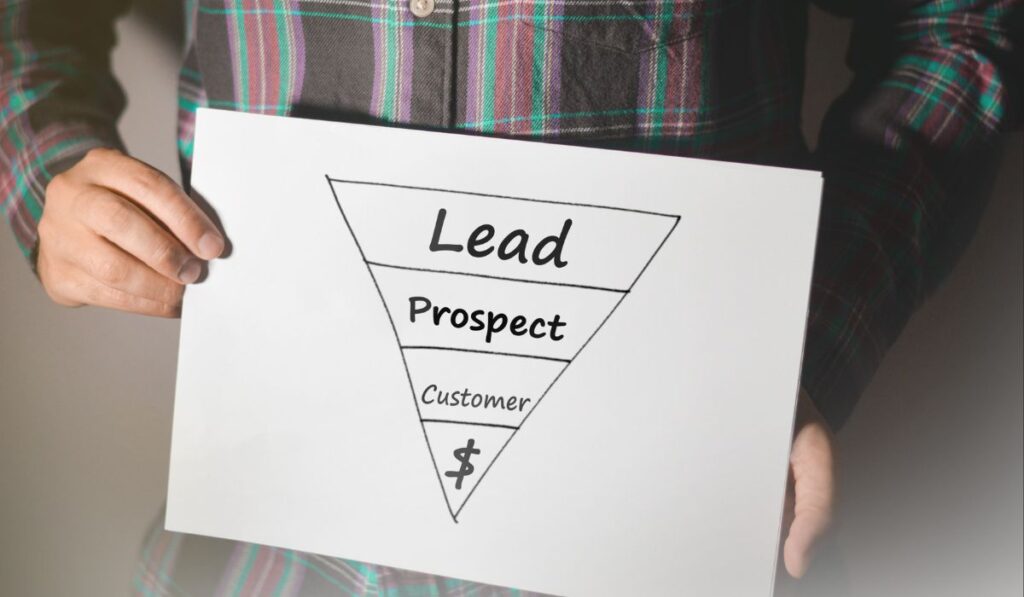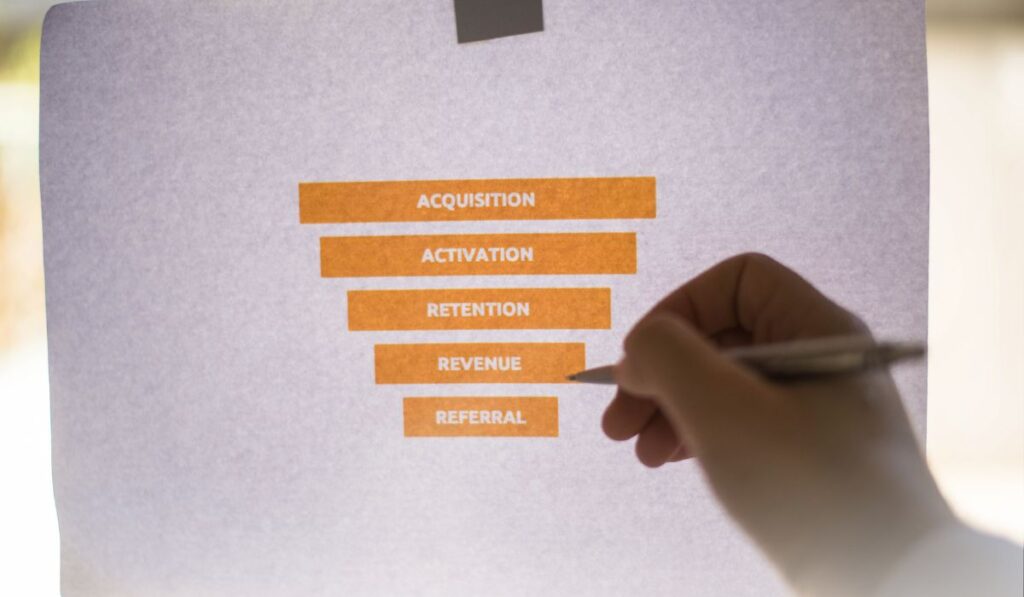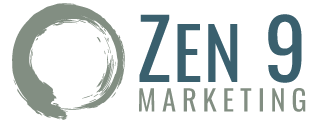Did you know up to 85% of website visitors are in the top funnel category in inbound marketing? This fact shows how key it is to grasp the inbound marketing sales funnel and its stages. We’re about to explore how businesses can guide prospects through their buyer’s journey.
The inbound marketing approach has changed how companies attract and engage potential customers. It focuses on creating value and building meaningful relationships. This method is more effective than traditional marketing, as it fits with today’s consumer decision-making.
Businesses use different strategies at each stage of the funnel to move leads closer to buying. From content that raises awareness to tactics that close deals, each stage needs a specific approach. By understanding these stages, companies can make more targeted and effective marketing campaigns.
Key Takeaways
- 85% of website visitors are in the top funnel stage
- Inbound marketing focuses on creating value for potential customers
- The funnel consists of four main stages: Attract, Convert, Close, and Delight
- Each stage requires specific strategies and content types
- Understanding the buyer’s journey is crucial for effective inbound marketing
- Personalized content and nurturing lead to higher conversion rates
Understanding the Fundamentals of Inbound Marketing
Inbound marketing is changing how businesses reach out to customers. It focuses on making content that draws in and keeps potential clients interested. Let’s explore the main ideas behind inbound marketing’s success.
What Sets Inbound Apart from Traditional Marketing
Inbound marketing is different from old-school methods. It aims to solve customer problems first. This method is cheaper and works better. In fact, inbound marketing can save up to 62% compared to traditional methods while getting three times more leads.
The Evolution of Customer-Centric Marketing
Marketing has shifted to focus more on the customer. Businesses now aim to create personal experiences that connect with their audience. This change has boosted engagement and loyalty, with inbound leads costing 80% less than traditional leads after just 4-5 months.
Key Principles of Inbound Strategy
An effective inbound marketing strategy is built on several key principles:
- Content creation: Making valuable, relevant content that meets customer needs
- SEO optimization: Making content easier to find in search engines to attract more visitors
- Lead nurturing: Building strong relationships with potential customers through tailored communication
- Data analysis: Always checking and improving strategies based on how well they work
By following these principles, businesses can achieve great results. Companies using inbound tactics get up to 126% more leads than those sticking to traditional methods. This shows the strength of a well-planned inbound marketing strategy in today’s digital world.
The Inbound Marketing Sales Funnel Explained
The inbound marketing sales funnel is a key tool for getting leads and improving conversions. We’ll explore the main stages of the marketing funnel. This will help you understand how to guide potential customers through their buying journey.

Our funnel has three main stages: Top of the Funnel (TOFU), Middle of the Funnel (MOFU), and Bottom of the Funnel (BOFU). Each stage is vital for nurturing leads and driving conversions.
- TOFU: Focuses on awareness and education
- MOFU: Emphasizes consideration and evaluation
- BOFU: Concentrates on decision-making and conversion
Research shows that 73% of B2B consumers review 3-7 pieces of content before talking to sales. This shows how crucial it is to create valuable content for each stage. Inbound marketing funnels usually have a 3% conversion rate. Each stage keeps about 10% of the previous stage’s visitors.
| Funnel Stage | Visitors | Conversion Rate |
|---|---|---|
| TOFU | 100 | 10% |
| MOFU | 10 | 10% |
| BOFU | 1 | 3% |
By grasping these marketing funnel stages, we can craft targeted content and strategies. This will enhance lead generation and increase conversion rates along the customer journey.
The Awareness Stage: Attracting Strangers
In today’s world, finding potential customers online is key. We create content that answers questions and solves problems people might not even know they have. This helps draw strangers into our sales funnel.
Creating Valuable Content for Top-of-Funnel
Creating content is essential for attracting strangers. We make blog posts, videos, and infographics that tackle common issues in our field. For instance, Casper’s sleep-related blog posts get over 10,000 visitors a month, showing the power of useful content.
SEO and Content Distribution Strategies
SEO is crucial for making our content easy to find. We use tools like Semrush’s Keyword Magic Tool to find keywords that are searched a lot but not too competitive. This helps us attract prospects effectively at the top of the funnel.
Social Media Engagement Tactics
Social media is important for sharing our message. We interact with our audience on the platforms they use most, sharing our content and starting conversations. This fits with the trend of online research, as TrustRadius shows nearly 100% of B2B buyers prefer researching independently over sales pitches.
| Inbound Marketing Tactic | Effectiveness |
|---|---|
| Blog Posts | High |
| Social Media Content | Medium-High |
| YouTube Videos | High |
| Educational Webinars | Medium |
By using these strategies, we can attract and engage potential customers. This prepares the ground for the next steps in our inbound marketing funnel.
Converting Visitors into Leads
Turning website visitors into leads is key in inbound marketing. We create engaging content and optimize digital assets to get valuable contact info. This method is 10 times better than traditional methods for getting leads.
Lead Magnet Development
Lead magnets are great for generating leads. We make valuable content like e-books and webinars. Visitors get these in exchange for their contact info.
Call-to-Action Optimization
Good call-to-action (CTA) buttons are crucial for getting people to act. We make CTAs stand out and use words that push people to click. We place them where they’re most likely to be seen.
Landing Page Best Practices
Our landing pages are simple and clear. Each page has one main goal and no distractions. We use persuasive text, social proof, and easy forms to turn visitors into leads.
| Element | Best Practice |
|---|---|
| Headline | Clear, benefit-driven |
| Form | Short, only essential fields |
| CTA Button | Contrasting color, action-oriented text |
| Social Proof | Testimonials or trust badges |
These strategies have greatly improved our lead generation. The goal is to offer value at every step. This guides potential customers smoothly through the marketing funnel.
Nurturing Leads Through the Consideration Stage
Lead nurturing is key in guiding potential customers through the consideration stage. We focus on giving valuable content and personalized experiences. This helps address specific pain points and shows our solutions.

We create targeted materials that speak to leads at this stage. Our content includes in-depth blog posts, whitepapers, and case studies. These show our expertise and build trust. Creating valuable content is vital for engaging potential customers and moving them towards a decision.
Email marketing is a powerful tool for lead nurturing. We send tailored email sequences with relevant information based on a lead’s interests and behaviors. This keeps communication consistent and offers timely solutions to their challenges.
We use marketing automation tools to streamline our nurturing process. These tools help us track lead interactions, segment our audience, and deliver personalized content at scale. By using data-driven insights, we can improve our lead nurturing strategies and boost conversion rates.
The consideration stage is a critical point in the buyer’s journey. Our lead nurturing efforts during this phase help build stronger relationships with potential customers. This increases the chance of conversion and builds long-term loyalty.
Decision Stage: Closing the Deal
When leads reach the decision stage, it’s time to seal the deal. We focus on providing compelling content and streamlined processes to convert prospects into customers. Let’s explore key strategies for this crucial phase.
Sales Enablement Content
Sales enablement content plays a vital role in addressing buyer concerns. We create targeted materials that highlight our unique value propositions and answer specific questions. Case studies, product comparisons, and detailed FAQs help build trust and confidence in our offerings.
Conversion Rate Optimization
To boost our conversion rates, we implement various techniques. A/B testing landing pages, optimizing call-to-action buttons, and personalizing content based on user behavior are effective strategies. By continuously refining our approach, we can improve our conversion rates and close more deals.
Marketing Automation Strategies
Marketing automation streamlines the decision-making process for both us and our customers. We use automated email sequences, personalized product recommendations, and triggered notifications to guide prospects towards a purchase. This approach ensures timely follow-ups and maintains engagement throughout the decision stage.
| Strategy | Impact | Implementation |
|---|---|---|
| Sales Enablement | Addresses buyer concerns | Case studies, FAQs, product comparisons |
| Conversion Optimization | Improves conversion rates | A/B testing, CTA optimization, personalization |
| Marketing Automation | Streamlines decision process | Email sequences, product recommendations, notifications |
By focusing on these key areas, we can effectively guide leads through the decision stage and increase our chances of closing deals. Remember, the key is to provide value, address concerns, and make the purchasing process as smooth as possible for our potential customers.
Measuring Success in Your Inbound Marketing Sales Funnel
It’s key to track the right metrics to see how well your inbound marketing works. We look at important KPIs to understand our marketing’s success.
Key Performance Indicators
Website traffic is a basic metric we watch. It shows how well our content is doing and where we can grow. We aim for more visitors each quarter, thanks to new, easy-to-find content.
For B2B marketers, Marketing Qualified Leads (MQLs) are crucial. More MQLs mean more potential customers. We also keep an eye on opportunities created, as it shows our marketing’s ROI.
Analytics and Reporting Tools
We use many marketing analytics tools to track these KPIs. Google Analytics gives us deep insights into our website and how users behave. Our CRM system helps manage leads, and social media analytics tools check how our content does on different platforms.
ROI Assessment Methods
Revenue is the best way to measure inbound success. It shows how much we’ve grown year-over-year and how well we convert leads into customers. We use closed-loop reporting with tools like website analytics, marketing automation, CRM, and BI. This lets us compare metrics, segment data, and get real-time insights without manual work.
By focusing on these KPIs and using strong analytics tools, we can keep improving our inbound marketing. This way, we can make sure our ROI measurements are accurate.
Common Challenges and Solutions
Inbound marketing challenges can seem overwhelming, but they can be solved. We’ve found the main problems and ways to fix them. This will help you improve your strategy.
One big challenge is making consistent, high-quality content. To solve this, create a detailed content plan. Plan your topics ahead of time and use an editorial calendar. Also, try different content types to keep your audience interested. This way, you’ll always have something valuable to share, helping you overcome common inbound marketing.
Another problem is getting sales and marketing teams to work together. Hold regular meetings between them to make sure everyone is in sync. Share goals, metrics, and customer feedback to work as a team. This teamwork will make your leads better and increase your chances of converting them.
Figuring out your ROI can be hard. Use advanced analytics tools to track your performance from start to finish. Set clear goals and check your data often to find ways to get better. This method is key for making your strategy work.
- 94% of business buyers research online before deciding
- 77% of prospects use Google search during research
- 84.3% of potential customers check business websites
By tackling these challenges directly, you’ll be ready to deal with the complex world of inbound marketing. Remember, keep trying and always look for ways to get better. This is the secret to lasting success.
Advanced Funnel Optimization Techniques
We’re exploring top-notch ways to boost your inbound marketing funnel. With smart strategies and the right tools, you’ll see a big jump in conversion rates. This will lead to greater marketing success.
A/B Testing Strategies
A/B testing is vital for fine-tuning your funnel. We test different versions of landing pages, emails, and ads. This helps us find out what works best with our audience.
This data-driven method lets us make smart choices. We keep improving our funnel’s performance.
Personalization Tactics
Personalization is crucial for connecting with potential customers. We segment our audience based on behavior, demographics, and purchase history. This way, we can create customized funnel paths.
These paths meet specific customer needs. This makes our marketing more relevant and boosts conversion rates.
Marketing Technology Stack Integration
A well-integrated marketing technology stack is essential for an optimized funnel. We use tools for automation, analytics, and customer relationship management. This makes our processes smoother.
This integration gives leads a seamless experience. They move smoothly from awareness to purchase.
By using these advanced techniques, businesses have seen better conversion rates and customer satisfaction. Remember, optimization is a continuous process. Always analyze your data, test new ideas, and refine your approach. This keeps your funnel at its best.
Building Long-term Customer Relationships
In the world of marketing, keeping customers is key. We focus on building strong relationships with our audience. By using smart strategies, we turn customers into loyal fans who share our brand with others.
Customer Retention Strategies
Happy customers help businesses grow. We keep them engaged with personalized messages and automation. We check in regularly, offer special deals, and create content that meets their needs.
Advocacy Program Development
Brand advocates are very valuable. We help happy customers become ambassadors through referrals and testimonials. These efforts boost our reputation and drive conversions through real recommendations.
| Strategy | Impact | Implementation |
|---|---|---|
| Personalized Email Campaigns | 57% increase in engagement | Segment lists, tailor content |
| Loyalty Programs | 30% boost in repeat purchases | Tiered rewards, exclusive perks |
| Customer Feedback Loop | 40% improvement in satisfaction | Regular surveys, action on insights |
We focus on strategies that make customers happy and loyal. This approach not only keeps customers but also turns them into brand advocates.
Learn More About the Inbound Marketing Sales Funnel with Zen 9 Marketing
We’ve looked into the inbound marketing sales funnel, a key for businesses wanting to grow. This comprehensive marketing strategy helps attract, engage, and delight customers. It’s proven to work, generating three times as many leads at a 62% lower cost than old methods.
Exploring the funnel stages shows the need for tailored content and personal experiences. By meeting customer needs at each stage, businesses build trust and long-term relationships. Over 70% of social media users will recommend a brand after a good experience, showing the power of inbound marketing.
In conclusion, inbound marketing’s success depends on always improving and being adaptable. Despite 32% of marketers feeling they’re not getting the results they want, this is a chance to grow. By using SEO, making valuable content, and focusing on conversions, businesses can overcome challenges and get great results. Let’s use the inbound approach to make our marketing a powerful tool for growth.
Looking for an inbound marketing agency near me? Contact Zen 9 Marketing – we can help!

